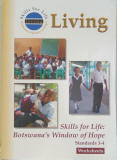|
December 2006
 TATITOWN - As the afternoon sun bakes the red Botswana dirt outside a
classroom at Tashatha Junior Secondary School, students inside seem
unaffected by the heat. They sit in their blue and white school uniforms,
the boys with their ties loosened at the neck, listening intently to the
story of Goabaone. TATITOWN - As the afternoon sun bakes the red Botswana dirt outside a
classroom at Tashatha Junior Secondary School, students inside seem
unaffected by the heat. They sit in their blue and white school uniforms,
the boys with their ties loosened at the neck, listening intently to the
story of Goabaone.
The 14-year-old girl is smart and gets good grades, but she also hangs
out with a wild group of friends who like to drink alcohol and get into
trouble. Goabaone's lifestyle and personal choices are now threatening to
affect her health and her future.
The story is from a new life skills manual developed to support HIV and AIDS
curriculum in Botswana's schools. It was designed by the Ministry of
Education and BOTUSA, a partnership between the U.S. Centers for Disease
Control and Prevention (CDC) and the Government of Botswana. The materials
were funded in part by the U.S. President's Emergency Plan.
Goabaone is a fictional character in the manual, but her situation seems
to have hit close to home for one student at Tashatha who shares the same
name.
"When I read this, I saw that I was this girl," the real Goabaone tells
the classroom, as her friends break out in giggles. "I thought of my friends
and how they act, it was too much related. It made me realize I need to
change."
The Botswana's Window of Hope: Skills for Life curriculum
materials are intended to help teachers discuss life issues important to
young Batswana who are growing up in a region where 25 percent of the
sexually active population 15-49 is thought to be infected with HIV (BAIS II
2004).
Five sets of teacher guides and learner workbooks were developed at
different levels from primary to senior secondary school. They were released
at a special launch in July 2006 and are being distributed throughout
Botswana by the Ministry of Education.
Prior to the development of the material, a needs assessment conducted in
selected primary and secondary schools revealed that most schools were using
materials that were not appropriate for young learners.
The new manuals use stories and characters with familiar names, role
playing, poems, and class discussions to help teachers impart knowledge and
build skills for decision-making in Botswana's young people. Topics include
self-awareness, goal-setting, managing stress, sexuality, facts and myths
about HIV/AIDS, benefits of relationships, risk reduction, social
responsibility and healthy living.
"The survival of learners depends on the acquisition of such skills,"
says Susan Makgothi, Director of Curriculum Development and Evaluation in
the Botswana Ministry of Education.
The manual is part of an "AB project" meant to teach skills that promote
abstinence and being faithful to one partner. The materials aim to promote
abstinence and emphasize delaying sexual debut until one is old enough to
make informed choices.
Some stories are taken directly from real life examples. Under the
chapter, "Benefits of Relationships," the manual tells the story of
Botswana's first president, Sir Seretse Khama and his wife, Ruth Williams,
who fell in love and got married when the young Khama was studying in the
United Kingdom. But the marriage was met with a lot of resistance from the
Bamangwato tribe who did not want their chief to marry a white woman.
"They decided to stand together and support each other through those
trying times. They had a long and strong marriage, and together they were
great leaders of the nation," the story concludes. The material suggests
teachers follow the story with a discussion on committed relationships they
admire.
A 17-year-old student from Chobe Junior Secondary School in Kasane says
she appreciates how the stories in the workbook take into account the
maturity level of the students reading them. The stories are "more real" and
easier to relate to than simply hearing advice from their elders.
"I'm almost 18, but my mother has been giving me the same advice since I
was 13," she says. "If you can do this book for us, maybe you should make a
book for parents, too." |